Approaches to Training Need Analysis in Human Resource Management
VerifiedAdded on 2023/05/29
|7
|1482
|96
AI Summary
This article discusses the concept of training need analysis in human resource management and the different approaches used to identify employee training needs. The advantages of each approach, including observation, surveys, interviews, customer feedback, and performance management systems, are explored. The article also includes a personal reflection on the importance of communication and programming skills in the technology field.
Contribute Materials
Your contribution can guide someone’s learning journey. Share your
documents today.

HUMAN RESOURCE
MANAGEMENT – 882748
MANAGEMENT – 882748
Secure Best Marks with AI Grader
Need help grading? Try our AI Grader for instant feedback on your assignments.
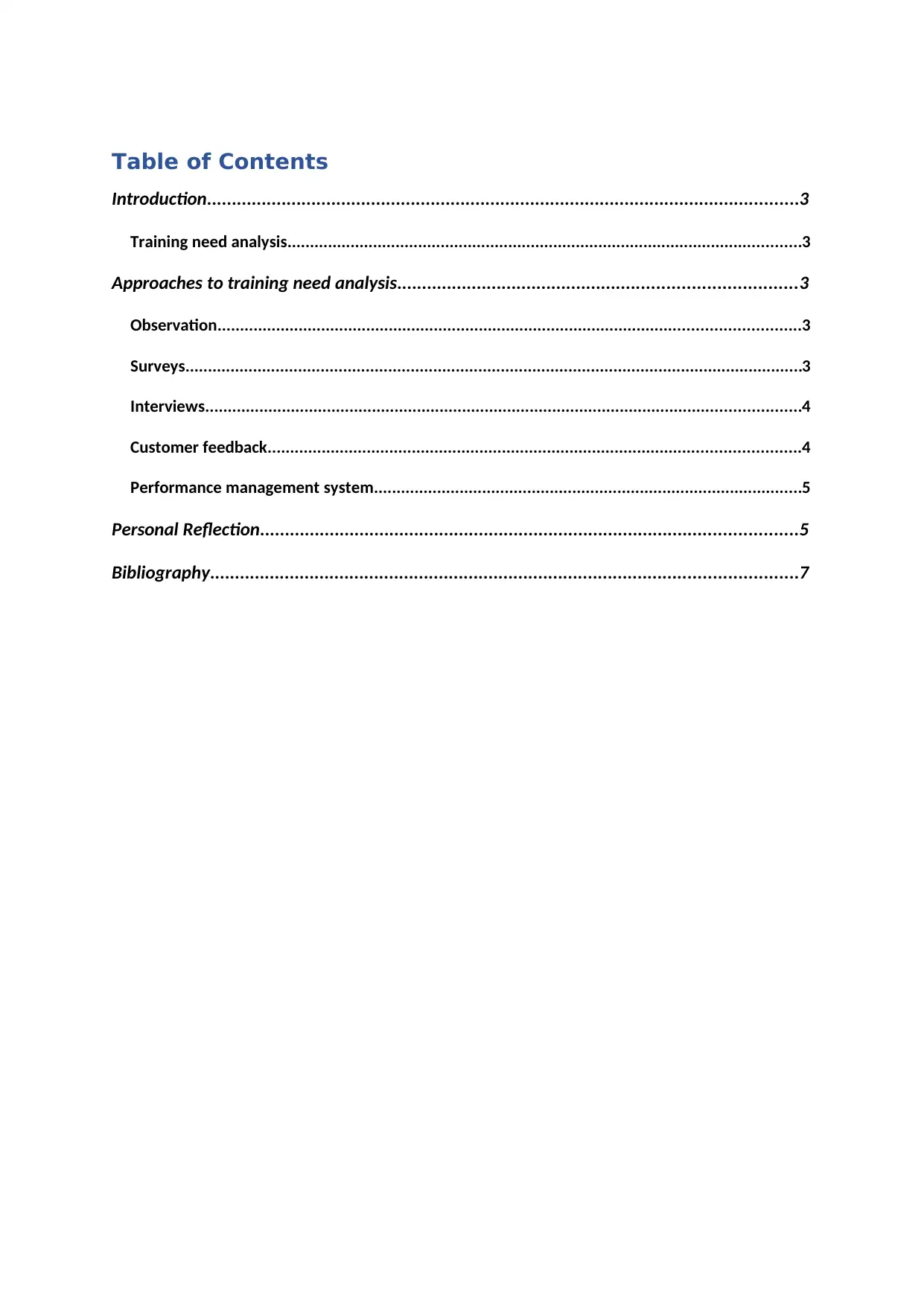
Table of Contents
Introduction.......................................................................................................................3
Training need analysis..................................................................................................................3
Approaches to training need analysis................................................................................3
Observation.................................................................................................................................3
Surveys.........................................................................................................................................3
Interviews....................................................................................................................................4
Customer feedback......................................................................................................................4
Performance management system...............................................................................................5
Personal Reflection............................................................................................................5
Bibliography......................................................................................................................7
Introduction.......................................................................................................................3
Training need analysis..................................................................................................................3
Approaches to training need analysis................................................................................3
Observation.................................................................................................................................3
Surveys.........................................................................................................................................3
Interviews....................................................................................................................................4
Customer feedback......................................................................................................................4
Performance management system...............................................................................................5
Personal Reflection............................................................................................................5
Bibliography......................................................................................................................7
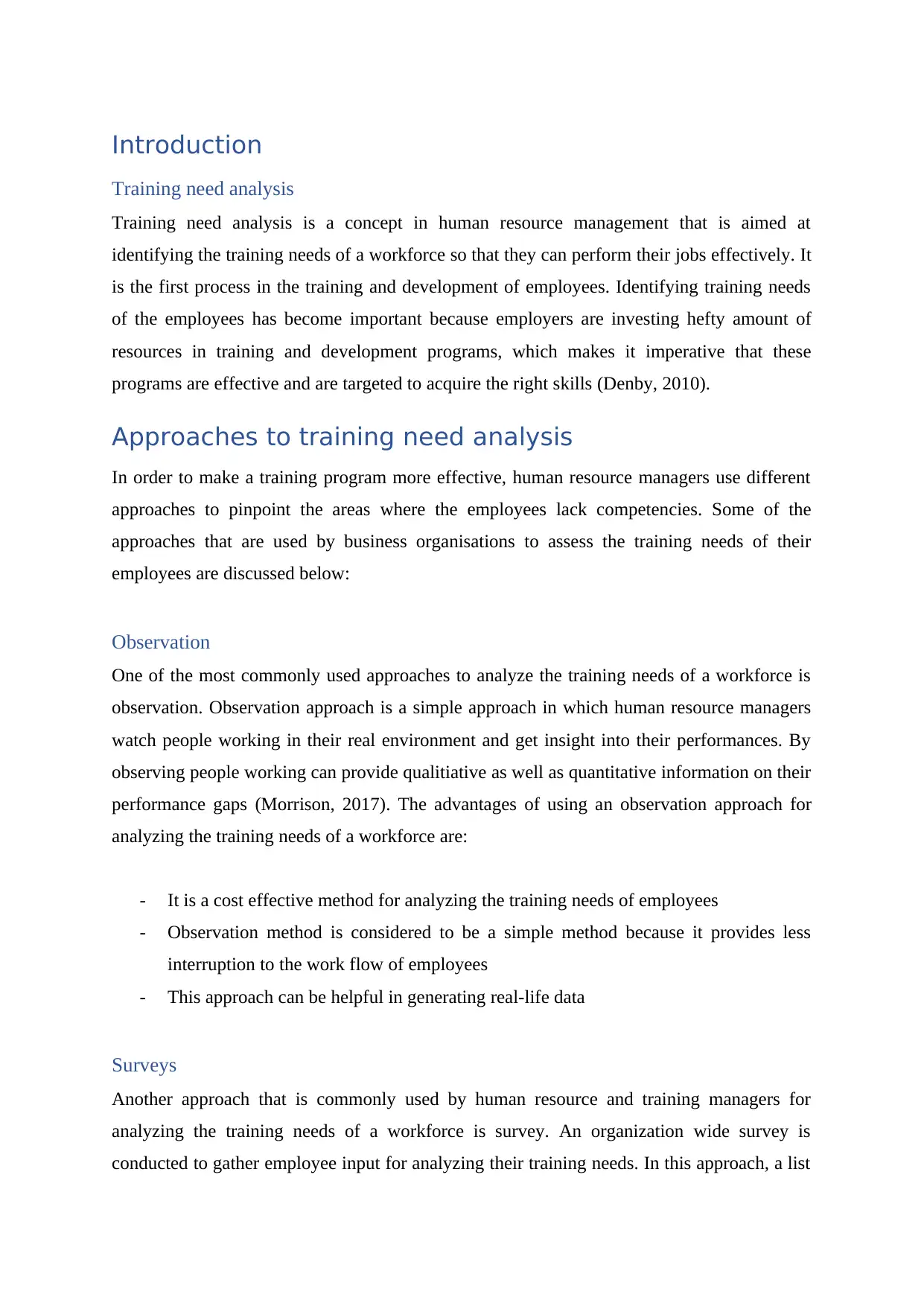
Introduction
Training need analysis
Training need analysis is a concept in human resource management that is aimed at
identifying the training needs of a workforce so that they can perform their jobs effectively. It
is the first process in the training and development of employees. Identifying training needs
of the employees has become important because employers are investing hefty amount of
resources in training and development programs, which makes it imperative that these
programs are effective and are targeted to acquire the right skills (Denby, 2010).
Approaches to training need analysis
In order to make a training program more effective, human resource managers use different
approaches to pinpoint the areas where the employees lack competencies. Some of the
approaches that are used by business organisations to assess the training needs of their
employees are discussed below:
Observation
One of the most commonly used approaches to analyze the training needs of a workforce is
observation. Observation approach is a simple approach in which human resource managers
watch people working in their real environment and get insight into their performances. By
observing people working can provide qualitiative as well as quantitative information on their
performance gaps (Morrison, 2017). The advantages of using an observation approach for
analyzing the training needs of a workforce are:
- It is a cost effective method for analyzing the training needs of employees
- Observation method is considered to be a simple method because it provides less
interruption to the work flow of employees
- This approach can be helpful in generating real-life data
Surveys
Another approach that is commonly used by human resource and training managers for
analyzing the training needs of a workforce is survey. An organization wide survey is
conducted to gather employee input for analyzing their training needs. In this approach, a list
Training need analysis
Training need analysis is a concept in human resource management that is aimed at
identifying the training needs of a workforce so that they can perform their jobs effectively. It
is the first process in the training and development of employees. Identifying training needs
of the employees has become important because employers are investing hefty amount of
resources in training and development programs, which makes it imperative that these
programs are effective and are targeted to acquire the right skills (Denby, 2010).
Approaches to training need analysis
In order to make a training program more effective, human resource managers use different
approaches to pinpoint the areas where the employees lack competencies. Some of the
approaches that are used by business organisations to assess the training needs of their
employees are discussed below:
Observation
One of the most commonly used approaches to analyze the training needs of a workforce is
observation. Observation approach is a simple approach in which human resource managers
watch people working in their real environment and get insight into their performances. By
observing people working can provide qualitiative as well as quantitative information on their
performance gaps (Morrison, 2017). The advantages of using an observation approach for
analyzing the training needs of a workforce are:
- It is a cost effective method for analyzing the training needs of employees
- Observation method is considered to be a simple method because it provides less
interruption to the work flow of employees
- This approach can be helpful in generating real-life data
Surveys
Another approach that is commonly used by human resource and training managers for
analyzing the training needs of a workforce is survey. An organization wide survey is
conducted to gather employee input for analyzing their training needs. In this approach, a list
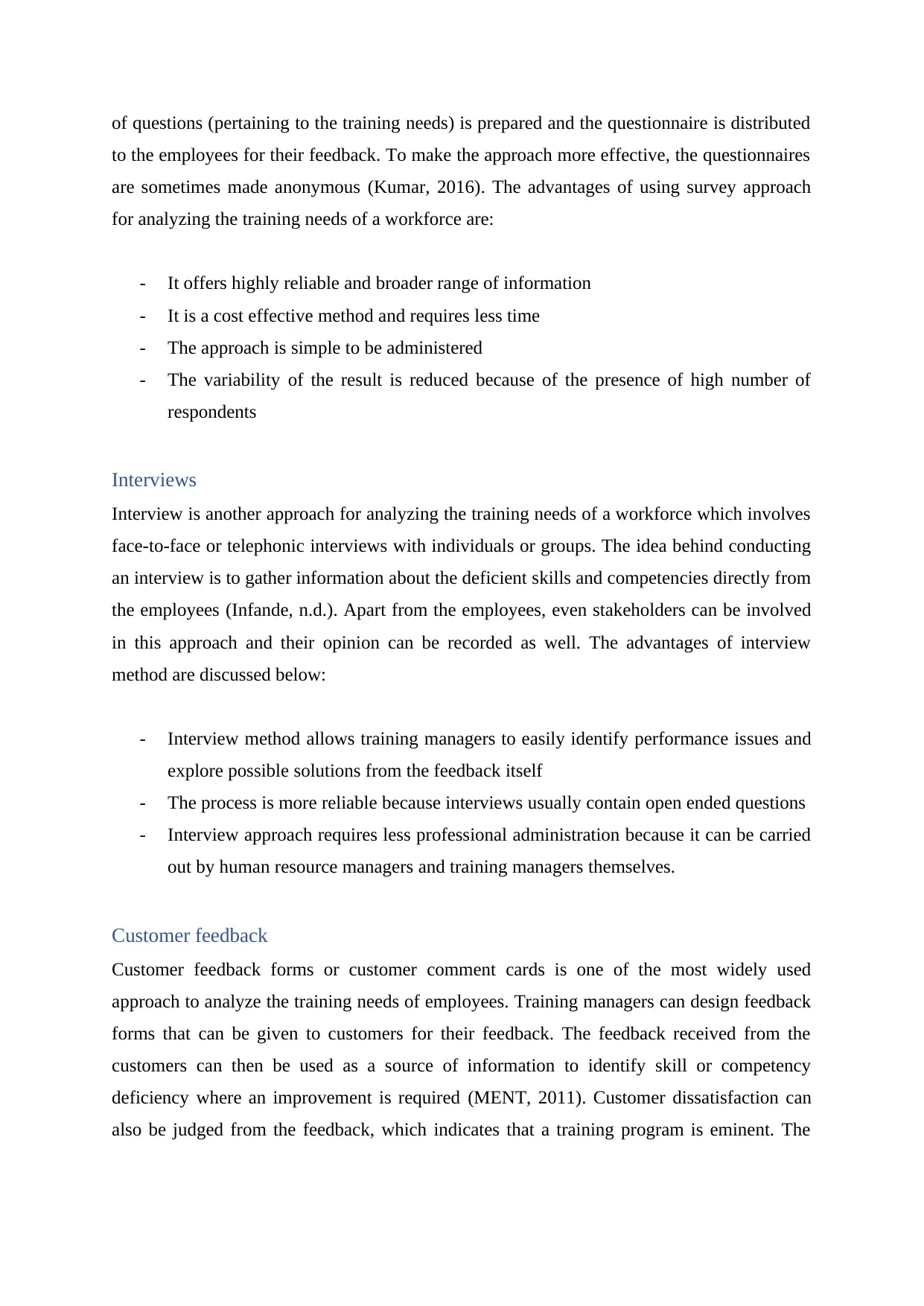
of questions (pertaining to the training needs) is prepared and the questionnaire is distributed
to the employees for their feedback. To make the approach more effective, the questionnaires
are sometimes made anonymous (Kumar, 2016). The advantages of using survey approach
for analyzing the training needs of a workforce are:
- It offers highly reliable and broader range of information
- It is a cost effective method and requires less time
- The approach is simple to be administered
- The variability of the result is reduced because of the presence of high number of
respondents
Interviews
Interview is another approach for analyzing the training needs of a workforce which involves
face-to-face or telephonic interviews with individuals or groups. The idea behind conducting
an interview is to gather information about the deficient skills and competencies directly from
the employees (Infande, n.d.). Apart from the employees, even stakeholders can be involved
in this approach and their opinion can be recorded as well. The advantages of interview
method are discussed below:
- Interview method allows training managers to easily identify performance issues and
explore possible solutions from the feedback itself
- The process is more reliable because interviews usually contain open ended questions
- Interview approach requires less professional administration because it can be carried
out by human resource managers and training managers themselves.
Customer feedback
Customer feedback forms or customer comment cards is one of the most widely used
approach to analyze the training needs of employees. Training managers can design feedback
forms that can be given to customers for their feedback. The feedback received from the
customers can then be used as a source of information to identify skill or competency
deficiency where an improvement is required (MENT, 2011). Customer dissatisfaction can
also be judged from the feedback, which indicates that a training program is eminent. The
to the employees for their feedback. To make the approach more effective, the questionnaires
are sometimes made anonymous (Kumar, 2016). The advantages of using survey approach
for analyzing the training needs of a workforce are:
- It offers highly reliable and broader range of information
- It is a cost effective method and requires less time
- The approach is simple to be administered
- The variability of the result is reduced because of the presence of high number of
respondents
Interviews
Interview is another approach for analyzing the training needs of a workforce which involves
face-to-face or telephonic interviews with individuals or groups. The idea behind conducting
an interview is to gather information about the deficient skills and competencies directly from
the employees (Infande, n.d.). Apart from the employees, even stakeholders can be involved
in this approach and their opinion can be recorded as well. The advantages of interview
method are discussed below:
- Interview method allows training managers to easily identify performance issues and
explore possible solutions from the feedback itself
- The process is more reliable because interviews usually contain open ended questions
- Interview approach requires less professional administration because it can be carried
out by human resource managers and training managers themselves.
Customer feedback
Customer feedback forms or customer comment cards is one of the most widely used
approach to analyze the training needs of employees. Training managers can design feedback
forms that can be given to customers for their feedback. The feedback received from the
customers can then be used as a source of information to identify skill or competency
deficiency where an improvement is required (MENT, 2011). Customer dissatisfaction can
also be judged from the feedback, which indicates that a training program is eminent. The
Secure Best Marks with AI Grader
Need help grading? Try our AI Grader for instant feedback on your assignments.
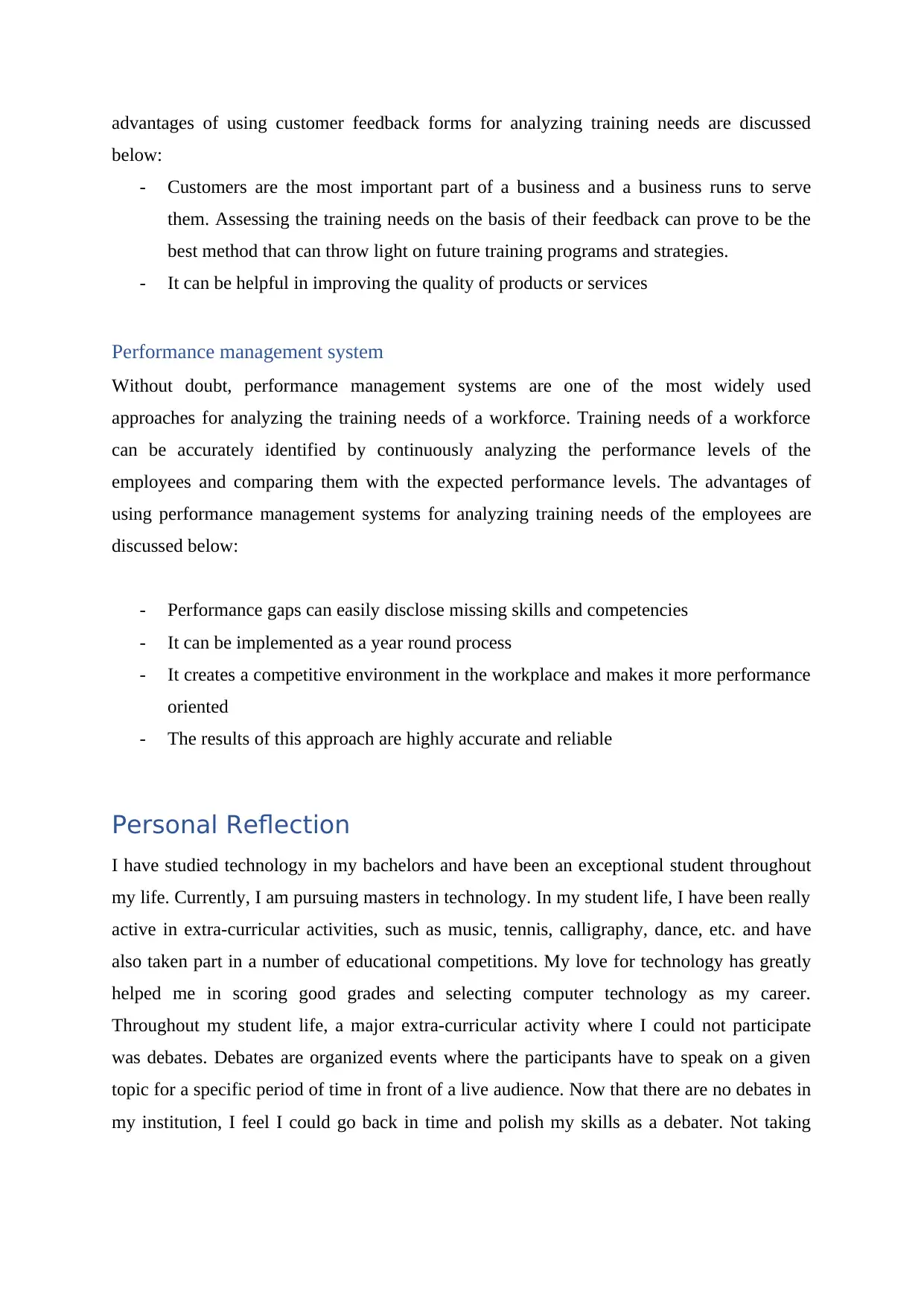
advantages of using customer feedback forms for analyzing training needs are discussed
below:
- Customers are the most important part of a business and a business runs to serve
them. Assessing the training needs on the basis of their feedback can prove to be the
best method that can throw light on future training programs and strategies.
- It can be helpful in improving the quality of products or services
Performance management system
Without doubt, performance management systems are one of the most widely used
approaches for analyzing the training needs of a workforce. Training needs of a workforce
can be accurately identified by continuously analyzing the performance levels of the
employees and comparing them with the expected performance levels. The advantages of
using performance management systems for analyzing training needs of the employees are
discussed below:
- Performance gaps can easily disclose missing skills and competencies
- It can be implemented as a year round process
- It creates a competitive environment in the workplace and makes it more performance
oriented
- The results of this approach are highly accurate and reliable
Personal Reflection
I have studied technology in my bachelors and have been an exceptional student throughout
my life. Currently, I am pursuing masters in technology. In my student life, I have been really
active in extra-curricular activities, such as music, tennis, calligraphy, dance, etc. and have
also taken part in a number of educational competitions. My love for technology has greatly
helped me in scoring good grades and selecting computer technology as my career.
Throughout my student life, a major extra-curricular activity where I could not participate
was debates. Debates are organized events where the participants have to speak on a given
topic for a specific period of time in front of a live audience. Now that there are no debates in
my institution, I feel I could go back in time and polish my skills as a debater. Not taking
below:
- Customers are the most important part of a business and a business runs to serve
them. Assessing the training needs on the basis of their feedback can prove to be the
best method that can throw light on future training programs and strategies.
- It can be helpful in improving the quality of products or services
Performance management system
Without doubt, performance management systems are one of the most widely used
approaches for analyzing the training needs of a workforce. Training needs of a workforce
can be accurately identified by continuously analyzing the performance levels of the
employees and comparing them with the expected performance levels. The advantages of
using performance management systems for analyzing training needs of the employees are
discussed below:
- Performance gaps can easily disclose missing skills and competencies
- It can be implemented as a year round process
- It creates a competitive environment in the workplace and makes it more performance
oriented
- The results of this approach are highly accurate and reliable
Personal Reflection
I have studied technology in my bachelors and have been an exceptional student throughout
my life. Currently, I am pursuing masters in technology. In my student life, I have been really
active in extra-curricular activities, such as music, tennis, calligraphy, dance, etc. and have
also taken part in a number of educational competitions. My love for technology has greatly
helped me in scoring good grades and selecting computer technology as my career.
Throughout my student life, a major extra-curricular activity where I could not participate
was debates. Debates are organized events where the participants have to speak on a given
topic for a specific period of time in front of a live audience. Now that there are no debates in
my institution, I feel I could go back in time and polish my skills as a debater. Not taking
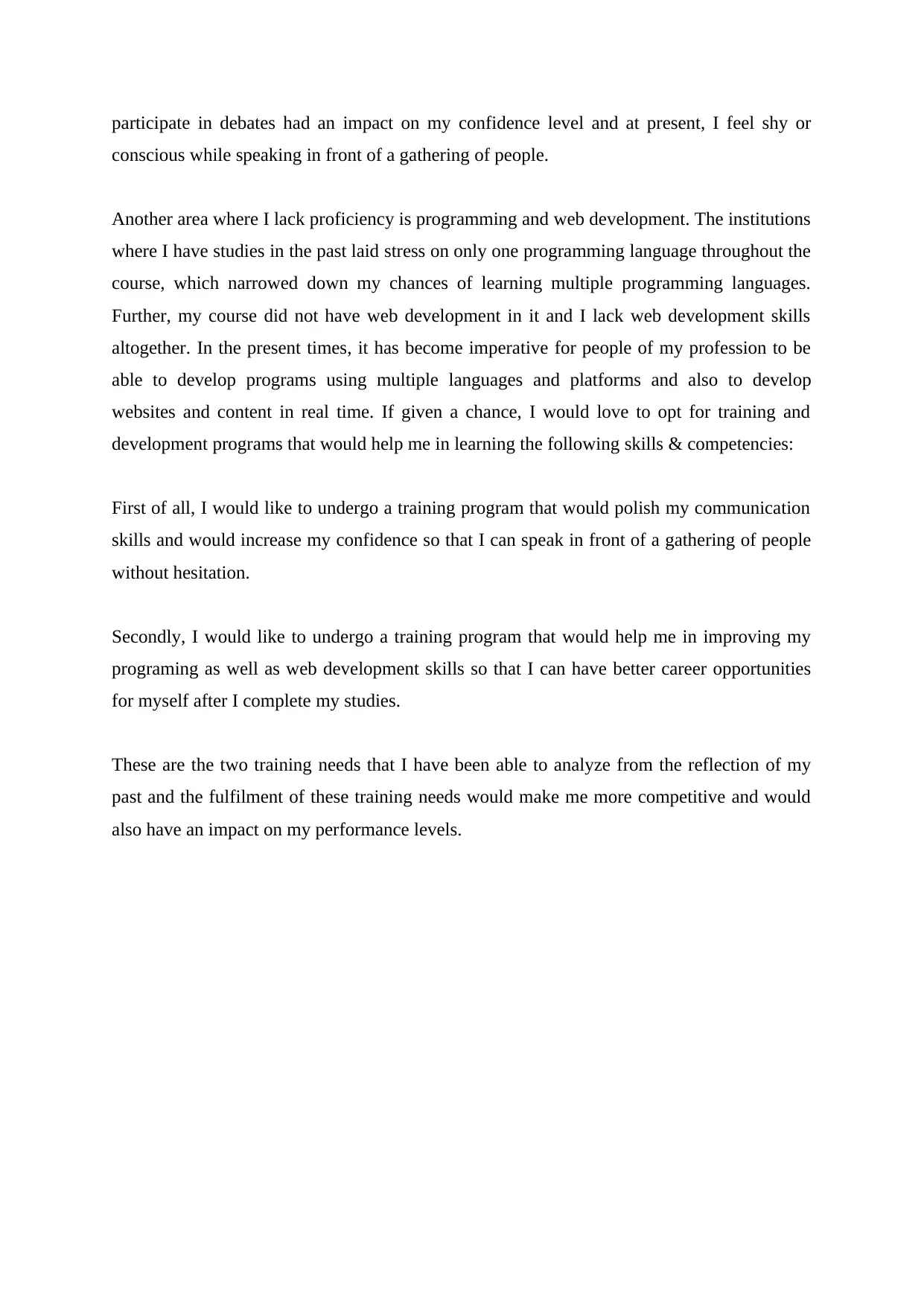
participate in debates had an impact on my confidence level and at present, I feel shy or
conscious while speaking in front of a gathering of people.
Another area where I lack proficiency is programming and web development. The institutions
where I have studies in the past laid stress on only one programming language throughout the
course, which narrowed down my chances of learning multiple programming languages.
Further, my course did not have web development in it and I lack web development skills
altogether. In the present times, it has become imperative for people of my profession to be
able to develop programs using multiple languages and platforms and also to develop
websites and content in real time. If given a chance, I would love to opt for training and
development programs that would help me in learning the following skills & competencies:
First of all, I would like to undergo a training program that would polish my communication
skills and would increase my confidence so that I can speak in front of a gathering of people
without hesitation.
Secondly, I would like to undergo a training program that would help me in improving my
programing as well as web development skills so that I can have better career opportunities
for myself after I complete my studies.
These are the two training needs that I have been able to analyze from the reflection of my
past and the fulfilment of these training needs would make me more competitive and would
also have an impact on my performance levels.
conscious while speaking in front of a gathering of people.
Another area where I lack proficiency is programming and web development. The institutions
where I have studies in the past laid stress on only one programming language throughout the
course, which narrowed down my chances of learning multiple programming languages.
Further, my course did not have web development in it and I lack web development skills
altogether. In the present times, it has become imperative for people of my profession to be
able to develop programs using multiple languages and platforms and also to develop
websites and content in real time. If given a chance, I would love to opt for training and
development programs that would help me in learning the following skills & competencies:
First of all, I would like to undergo a training program that would polish my communication
skills and would increase my confidence so that I can speak in front of a gathering of people
without hesitation.
Secondly, I would like to undergo a training program that would help me in improving my
programing as well as web development skills so that I can have better career opportunities
for myself after I complete my studies.
These are the two training needs that I have been able to analyze from the reflection of my
past and the fulfilment of these training needs would make me more competitive and would
also have an impact on my performance levels.
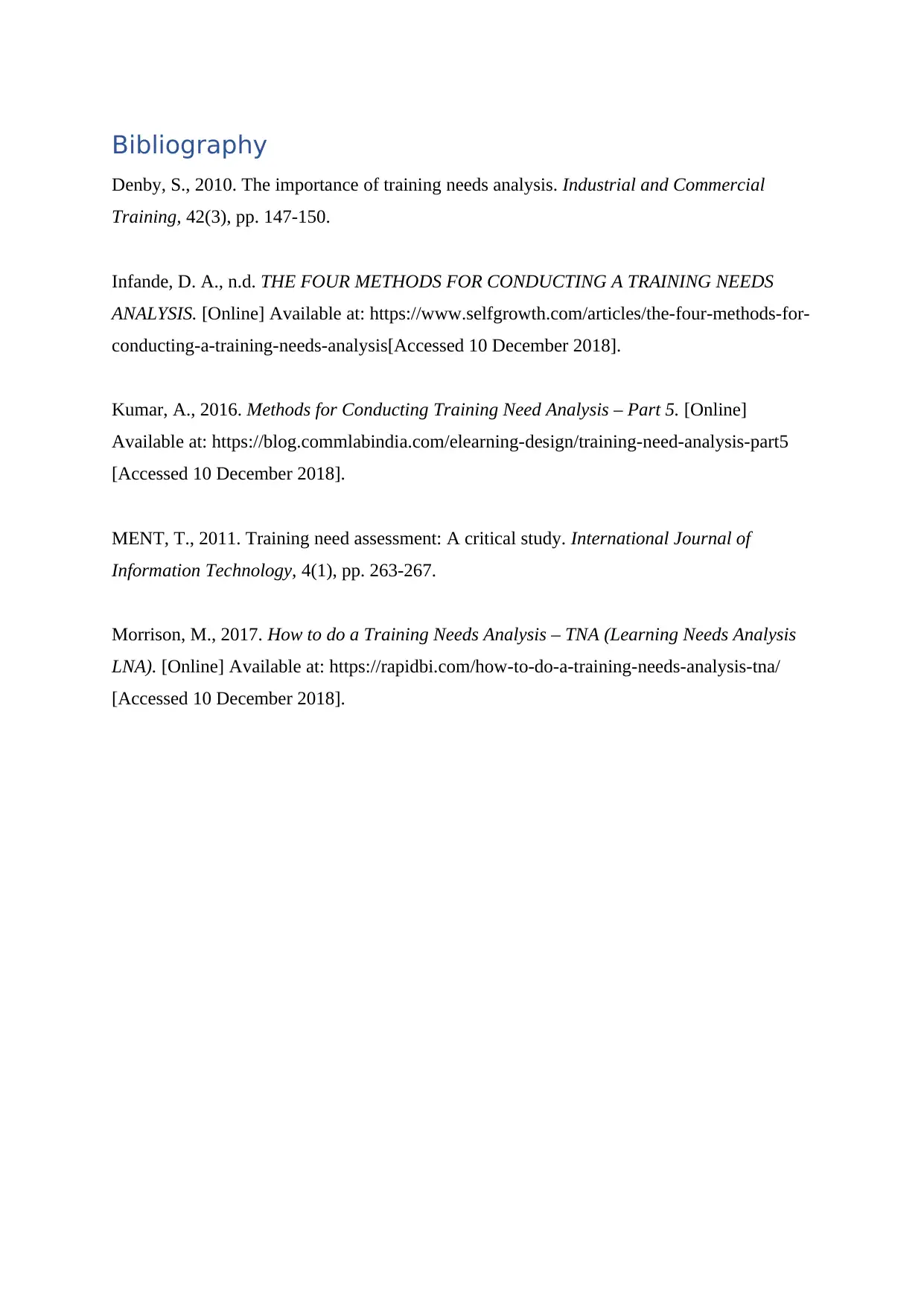
Bibliography
Denby, S., 2010. The importance of training needs analysis. Industrial and Commercial
Training, 42(3), pp. 147-150.
Infande, D. A., n.d. THE FOUR METHODS FOR CONDUCTING A TRAINING NEEDS
ANALYSIS. [Online] Available at: https://www.selfgrowth.com/articles/the-four-methods-for-
conducting-a-training-needs-analysis[Accessed 10 December 2018].
Kumar, A., 2016. Methods for Conducting Training Need Analysis – Part 5. [Online]
Available at: https://blog.commlabindia.com/elearning-design/training-need-analysis-part5
[Accessed 10 December 2018].
MENT, T., 2011. Training need assessment: A critical study. International Journal of
Information Technology, 4(1), pp. 263-267.
Morrison, M., 2017. How to do a Training Needs Analysis – TNA (Learning Needs Analysis
LNA). [Online] Available at: https://rapidbi.com/how-to-do-a-training-needs-analysis-tna/
[Accessed 10 December 2018].
Denby, S., 2010. The importance of training needs analysis. Industrial and Commercial
Training, 42(3), pp. 147-150.
Infande, D. A., n.d. THE FOUR METHODS FOR CONDUCTING A TRAINING NEEDS
ANALYSIS. [Online] Available at: https://www.selfgrowth.com/articles/the-four-methods-for-
conducting-a-training-needs-analysis[Accessed 10 December 2018].
Kumar, A., 2016. Methods for Conducting Training Need Analysis – Part 5. [Online]
Available at: https://blog.commlabindia.com/elearning-design/training-need-analysis-part5
[Accessed 10 December 2018].
MENT, T., 2011. Training need assessment: A critical study. International Journal of
Information Technology, 4(1), pp. 263-267.
Morrison, M., 2017. How to do a Training Needs Analysis – TNA (Learning Needs Analysis
LNA). [Online] Available at: https://rapidbi.com/how-to-do-a-training-needs-analysis-tna/
[Accessed 10 December 2018].
1 out of 7
Related Documents
Your All-in-One AI-Powered Toolkit for Academic Success.
+13062052269
info@desklib.com
Available 24*7 on WhatsApp / Email
![[object Object]](/_next/static/media/star-bottom.7253800d.svg)
Unlock your academic potential
© 2024 | Zucol Services PVT LTD | All rights reserved.




